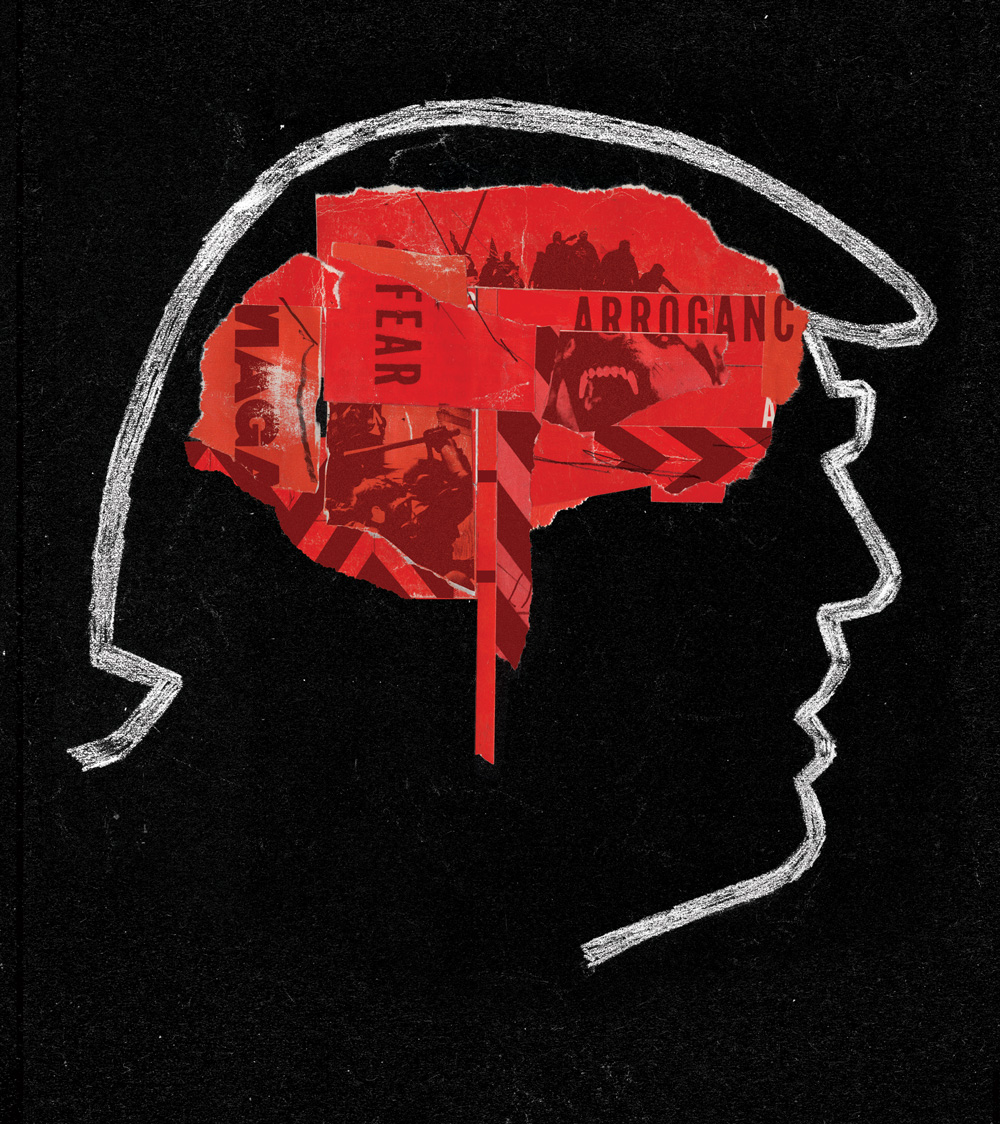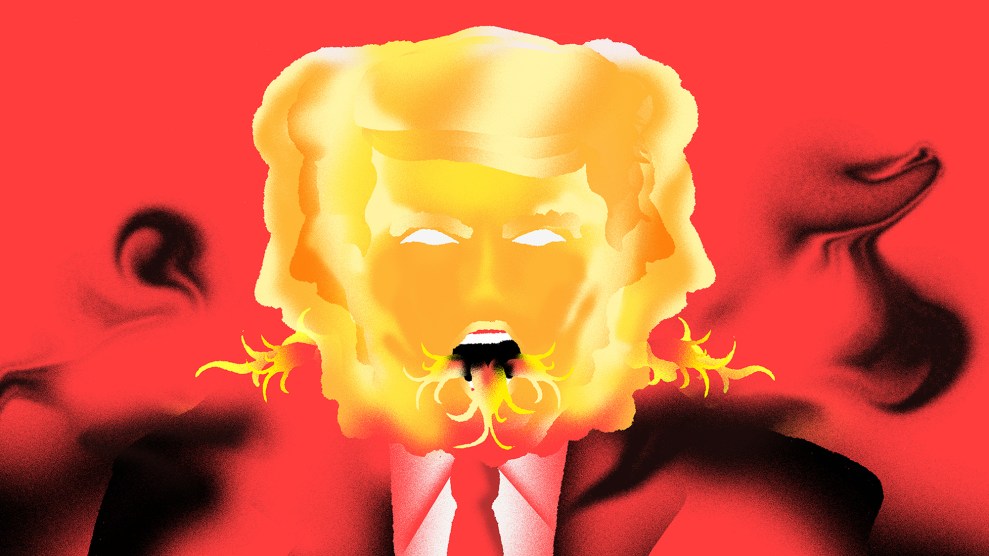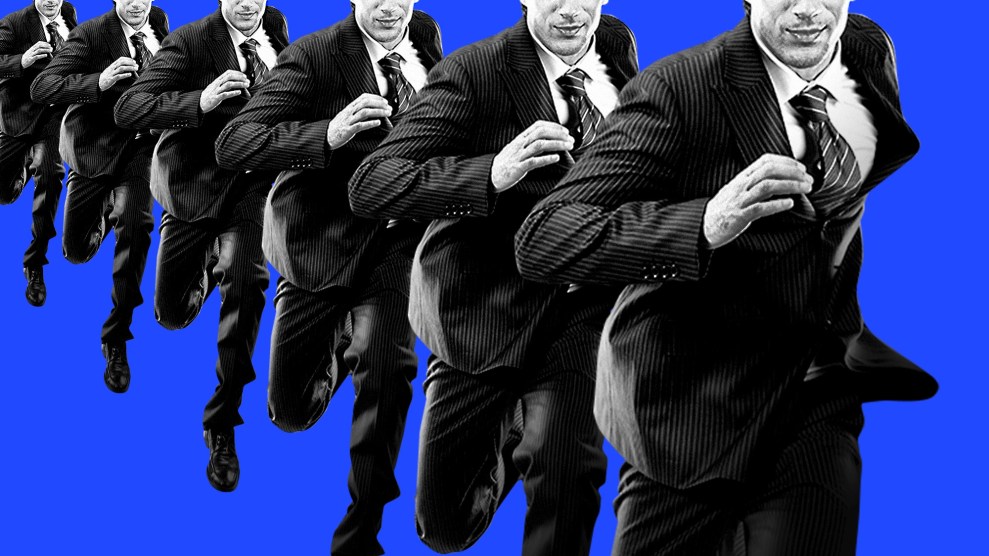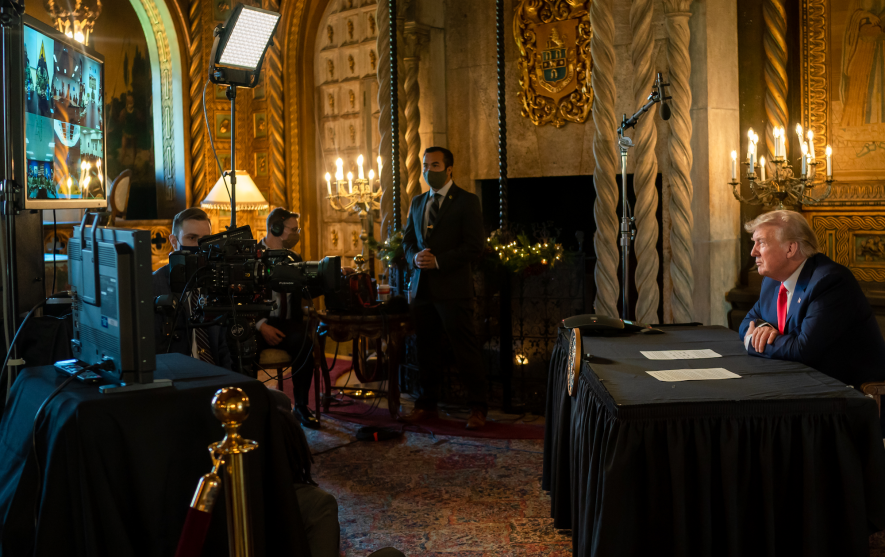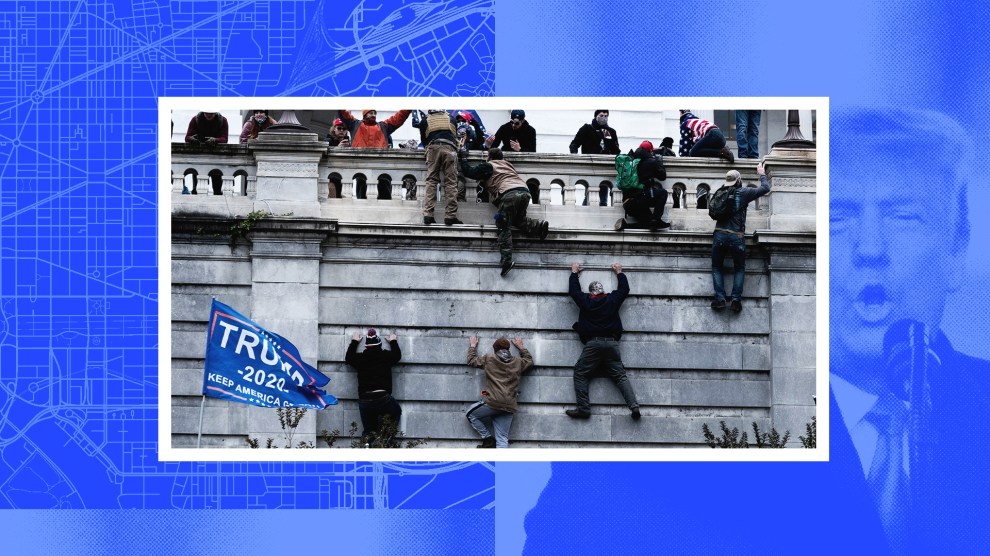On the afternoon of February 1, 2016, as Iowa voters prepared for that evening’s caucuses, Bandy Lee sat by the bedside of her mother, who was terminally ill with cancer. An assistant professor of clinical psychiatry at Yale, Lee had been too preoccupied with her mother’s condition to pay attention to the nascent presidential race, so she was taken aback when she saw footage of a Donald Trump rally airing on the hospital room’s small TV. What shocked her was the way Trump interacted with the crowd. “He said something about how his supporters should knock the crap out of hecklers,” she recalls, “and that if they did, he would pay their legal bills.”
His belligerent behavior meant more to Lee than it might to a casual viewer. As part of her clinical work in prison settings, she had evaluated and treated hundreds of violent offenders, including leaders of prison gangs. A native New Yorker, she had assumed that Trump “was just a shady businessman,” Lee told me, but “I suddenly realized that he had a lot in common” with those patients. “Trump was engaging in the predatory manipulation of his vulnerable followers.” In some cases, gang leaders might “ask their members to engage in violence and then issue bogus promises of protection. Like Trump, these leaders also often project extreme self-confidence, and that appeals to their followers, who tend to feel a deep emotional need for protection, connection, and identity.”
Fast forward to November 9, 2016, the day after the election. Lee’s friends and colleagues were bombarding her with calls and emails. Would Trump’s victory herald an increase in hate crimes? “You are a violence expert,” one implored. “Can you do something?”
She decided to jump into the fray, organizing an academic conference that took place in New Haven the following April. Titled “Does Professional Responsibility Include a Duty to Warn?” the meeting featured a handful of prominent psychiatrists, including Robert Jay Lifton, author of The Nazi Doctors (1986), who addressed Trump’s mental state and the risks they believed it posed to the health and safety of Americans. Their consensus was, as Lifton put it, that psychiatric professionals had a compelling ethical duty to “bring our experience and knowledge to bear on what threatens us and what might renew us.” The event was initially sponsored by Yale’s schools of public health, medicine, and nursing, but Lee ended up running it independently to avoid the perception of “politicization.”
On the day of the conference, when only two dozen people filed into the 450-seat auditorium, the speakers—who also included clinical psychiatry professor Judith Herman from Harvard Medical School, and New York University psychiatrist James Gilligan, who also specializes in violent behavior—were “disappointed,” Lee says. “We assumed that our effort was a failure until we saw the press coverage, which included write-ups in news outlets in [many] different countries.” She proceeded to solicit papers on Trump’s potential for violence from a couple dozen other mental health experts and published the entire collection that fall. The Dangerous Case of Donald Trump was a surprise bestseller, hailed by the Washington Post as “the most daring book” of 2017.

Bandy Lee felt she had a duty to warn the public of President Trump’s potential for violence.
Zach Gross
Shortly after the book came out, leaders of the American Psychiatric Association began publicly attacking Lee, arguing she was acting irresponsibly. Her alleged offense was violating the 1973 Goldwater Rule, an APA guideline stating that “it is unethical for a psychiatrist to offer a professional opinion” of anyone without conducting a personal examination and getting proper approval.
The rule was the APA’s response to a 1966 lawsuit by Barry Goldwater, the late Arizona senator and presidential candidate. Goldwater had successfully sued Fact magazine, which, shortly before the 1964 general election, ran a piece in which dozens of leading psychiatrists offered crude armchair assessments of the state of Goldwater’s psyche. “His impulsive, impetuous behavior…reflects an emotionally immature, unstable personality,” wrote one doctor, who went on to cite Goldwater’s “inability to dissociate himself from vituperative, sick extremists.” (While the archconservative’s fiery campaign speeches were startling to many Americans at the time, they now seem relatively tame compared with Trump’s.)
This was the heyday of classical Freudianism, and most of the Fact magazine commentary was rooted in theoretical mumbo jumbo rather than empirical facts. One psychiatrist declared that the “core of [Goldwater’s] paranoid personality is…his anality and latent homosexuality.” The legacy of these off-the-cuff evaluations is a primary reason that today’s APA leaders were so eager to quash Lee’s Trump commentary.
“Anything a psychiatrist says without examining a patient is likely to be inaccurate, so it can harm the public figure,” says Paul Appelbaum, a Columbia University professor who has served as the APA’s president. Appelbaum is also concerned that diagnosing people from a distance casts the profession in a negative light: “These seemingly cavalier and politically motivated public statements can prevent people from getting the psychiatric care that they need.”
And yet Lee’s Cassandra-like warnings turned out to be remarkably prescient. On the morning of the insurrection, as former White House aide Cassidy Hutchinson revealed in sworn testimony to the January 6 committee, Trump had no compunction about unleashing armed loyalists on the Capitol, and was furious when told he could not accompany them. Two days later, as Bob Woodward and Robert Costa reported in their book, Peril, House Speaker Nancy Pelosi seemed to channel Lee when she told General Mark Milley, the chairman of the Joint Chiefs of Staff, “This unhinged president could not be more dangerous. And we must do everything we can to protect the American people from his unbalanced assault on our country.”
We also know from January 6 testimony that key Republicans—including House Minority Leader Kevin McCarthy and Cabinet secretaries such as Steven Mnuchin and Betsy DeVos—discussed the possibility of invoking the 25th Amendment, which provides for removal of a president who is no longer fit to discharge his duties due to a mental or physical disability.
Trump, whose false (and contagious) claim that the 2020 election was stolen remains the centerpiece of his putative 2024 campaign, could still end up being the Republican frontrunner, despite his mounting legal troubles. In this context, Lee’s assessment begs a second look. The threat of violence, after all, was a staple of Republican campaign rhetoric even before the FBI’s search of Mar-a-Lago unleashed a fresh torrent of inciteful anti-government messaging from Republican lawmakers and right-wing extremists alike. Back in June, to offer just one example, Missouri Senate candidate and former governor Eric Greitens released an ad depicting a fully armed “MAGA crew” going RINO hunting. (Greitens, who had resigned his governership amid a sex scandal and other allegations, lost his August primary to Republican Eric Schmitt.)
As a pioneering scholar of violence, Lee has plenty to say about what can be done to address the growing disregard for law and democratic institutions that Trump helped normalize. Indeed, in January, well before this most recent surge of hyper-partisan vitriol, the Washington Post and the University of Maryland published a poll in which 34 percent of participants—and about 40 percent of participating Republicans and independents—said political violence is sometimes justifiable.
The warning signs have long been there for all to see. Ever since June 2015, when Trump descended the escalator in Trump Tower to announce his candidacy, he has repeatedly embraced violence in support of his political goals. Roughly two months after the Iowa caucuses, when his campaign manager Corey Lewandowski was arrested for manhandling a female reporter, Trump responded with gaslighting: “It was almost like he was trying to keep her off me, like he was trying to help her.”
Instead of denouncing the white supremacists who organized the 2017 Charlottesville rally that turned violent, Trump said there were “very fine people on both sides.” And during his first debate with Joe Biden, Trump refused to condemn the Proud Boys, a violent extremist group that would play a pivotal role in the Capitol assault, instead telling them to “stand back and stand by.”
No former president since John Tyler—who later became a Confederate lawmaker—has warmed to the prospect of civil war quite as much as Trump, who in late May “re-truthed” a post on his social media platform positing it as a solution for our “failing” nation. His followers may be on the same page. In a poll published a week or so later, more than half of the Republican respondents said America “seems headed toward a civil war in the near future.” The Mar-a-Lago search generated further talk of civil war on social media channels, along with calls to target judges and federal agents that at least one participant acted upon.
Lee’s professional interests date back to her childhood in a run-down neighborhood just south of the New York Botanical Garden. “The windows of my junior high school were strewn with bullet holes,” she recalls. “In the 1980s, Albanian, Chinese, and African American teenage gangs patrolled the Bronx. I grew up never imagining that I wouldn’t be looking over my shoulder to check that I was safe.”
After graduating from Yale Medical School in 1994, Lee devoted her career to studying, predicting, and preventing violence. Early in her residency at Harvard’s Massachusetts General Hospital, she jumped at the chance to provide therapy to inmates at Boston’s Suffolk County Jail. “I identify with perpetrators of violent crimes,” she explains. “There is a paper-thin difference between becoming one of them and doing what I do. I’ve lived in their surroundings and I know their mindset.”
In addition to studying the perpetrators, she has focused on the broader topic of how societies view and process violence. America’s leaders have historically perceived it primarily through the lens of crime and punishment, “but I see it as a serious public health problem, which we need to address by means of scientific principles.”
In 1997, she began working with James Gilligan, then one of her Harvard mentors, on the Resolve to Stop the Violence Project. Supported by a $2.6 million grant from the Soros Foundation, the pair established an experimental program for violent offenders in a San Francisco jail.
By immersing the men in an intensive six-day-a-week rehabilitation regimen that combined psychotherapy with training in social skills such as empathy, accountability, and creative expression, RSVP reduced the annual rate of violent incidents in the 62-bed unit from about 25 to zero in the year after the program was launched. Among the prisoners who had spent at least 16 weeks in the program prior to release, re-arrests for violent crimes declined by 83 percent. (“In my psychiatric training, I was taught that violence was not treatable,” Lee recalls, “but this is false.”)
Lee also has consulted with government officials in Alabama, Connecticut, New York, and elsewhere—including France and Ireland—on prison reform projects, and has collaborated with fellow academics on the World Health Organization’s Violence Prevention Alliance. She has published more than 100 peer-reviewed articles and written or edited more than a dozen books on violence. Her 2019 textbook, Violence: An Interdisciplinary Approach to Causes, Consequences, and Cures, received plaudits from many experts in the field, including epidemiologist Gary Slutkin, the executive director of Cure Violence, a nonprofit that addresses violence in urban communities. “It’s an exceptional achievement,” he says. “This comprehensive look at the psychology, brain science, and sociology of violence” is helping to put the subject on the map as an academic discipline in its own right.
About 15 years ago, Lee and Gilligan began examining deaths by violence in America since 1900. As Lee sliced and diced their massive data set, she was shocked to find significantly higher national rates of violent death under Republican presidents than under Democratic ones. What’s more, murder and suicide rates were higher in states that had voted for Republican presidential candidates than in those that had voted for Democratic candidates. Their key findings were published as a 2011 monograph, Why Some Politicians Are More Dangerous Than Others.
“Since 1900, every time a Republican president has taken over, economic inequality has increased and the country has become more violent,” says Gilligan, now a professor of psychiatry at NYU. And as the government safety net has crumbled in recent decades, rates of murder, imprisonment, and poverty have been five to 10 times higher in the United States than in Western Europe, Canada, and Australasia. Lee and Gilligan had to circulate their data-driven paper on the political correlates of violent death rates for nearly seven years before they finally got it published in 2014 in a specialized journal, Aggression and Violent Behavior. “My sense is that our study kept getting rejected not because it was lousy science but because editors wanted to avoid appearing too political,” she says.
According to Lee, Trump’s extreme dangerousness puts him in a completely different category from previous Republican presidents, who merely endorsed a set of harsh economic policies that are associated with increased violence. In contrast to past presidents with likely personality disorders, she believes, Trump has a psychological profile that is common among violent offenders. “There is typically a developmental arrest caused by early trauma or abandonment,” Lee says. “As adults, they still act like children in the playground; convinced that might makes right, they often can’t stop bullying others. “Trump’s mother, Lee points out, became chronically ill when he turned two, and his father was cruel and emotionally unavailable, repeatedly urging his son to be “a killer.”
Her clinical insights into the criminal mind draw on the stage theory of morality devised by Harvard psychologist Lawrence Kohlberg. In Kohlberg’s model, which is backed up by empirical research on children, perpetrators of violence tend to be frozen in an early developmental stage: Like young children, they rarely take into account the concerns of others and tend to obey only those whom they fear. “Such adults are incapable of any sophisticated moral calculus,” Lee says. “For Trump, the only reason not to do something—even something that is likely to harm others—is to avoid punishment. And since he has rarely been held accountable for any misdeeds, he has come to believe that he has a carte blanche to do whatever serves his immediate needs.”
Despite the scolding directed her way by influential psychiatrists, Lee contends that she has never broken the Goldwater Rule, which, as she wrote in 2017, “is the norm of ordinary practice I happen to agree with.” In The Dangerous Case of Donald Trump, she and her co-authors challenged Trump’s fitness to serve based on his behavior rather than on a diagnosis per se. “The issue that we are raising is not whether Trump is mentally ill,” Gilligan writes in his chapter. “It is whether he is dangerous.” As proof of the psychological peril at hand, the authors point to Trump’s angry tirades and verbal abuse of subordinates, his admiration of authoritarian leaders, conspiratorial fantasies, aversion to facts, and attraction to violence.
Forensic psychiatrists like Lee and Gilligan are often asked to assess people imprisoned for violent acts and offer their expert opinions as to whether, if released, those prisoners are likely to re-offend. They follow a standard protocol, taking into account the person’s criminal history, ability to show remorse, and any lingering attraction toward violence they might exhibit. “Back in 2017, we followed the same protocol in assessing Trump’s potential for dangerousness,” Lee says. “Most Americans do not have direct experience dealing with people who commit violent crimes. But we do. And we could tell that someone who boasts about sexually assaulting women and says that he could shoot someone on Fifth Avenue and get away with it was likely to evolve into a president who would severely damage the nation’s public health.”
In early January 2018, the APA doubled down on the Goldwater Rule and issued a public statement urging all psychiatrists—even those, like Lee, who do not belong to the APA—to stop offering any public commentary about public figures. “Armchair psychiatry or the use of psychiatry as a political tool is,” the release asserted, “unacceptable and unethical.” The New York Times editorial board piled on the next day. In a piece titled “Is Mr. Trump Nuts?” the opinion editors called Lee out directly for speaking up about Trump.
Soon after, the Times published an op-ed by Columbia professor Jeffrey Lieberman, another former APA president, under the headline “Maybe Trump Is Not Mentally Ill. Maybe He’s Just a Jerk.” Lieberman accused psychiatrists who’d speculated about Trump’s mental state of “clinical name calling” and compared them to Soviet shrinks who misused their credentials to bolster a totalitarian regime. (In February, Lieberman was suspended from his post as chair of Columbia’s psychiatry department over a tweet that was widely seen as misogynistic and racist.)
By discrediting her academic work, Lee says, these broadsides essentially removed it from the public square. “After the New York Times endorsed the APA’s gag order, which sought to protect public figures rather than public health,” she says, “the rest of the mainstream media followed.”
Defenders of the Goldwater Rule consider it a critical ethical principle. “Trump’s outrageous behavior was public, and because of its flagrant nature, the public doesn’t need experts to interpret it,” says Richard Friedman, a professor of psychiatry at Weill Cornell Medical College and contributing opinion writer for the Times, who supports the APA’s position. “It’s also a fantasy to believe that experts could somehow rescue the nation from a bad character.”
Harvard’s Judith Herman, who spoke at Lee’s Trump conference, counters that the APA is on the wrong side of history. “In his work on tyranny, Yale historian Timothy Snyder emphasizes the value of courageous professional organizations,” she says. “If you see a proto-fascist movement, you can either be part of the resistance or you can go along to get along.” That view is shared by Norman Eisen, a senior fellow at the Brookings Institution, who worked as an ethics lawyer in the Obama White House. “We’ve never had such a mentally unfit president before. If more professionals had felt free to speak out, they might have made a difference,” he says.
Thomas Gutheil, a forensic psychiatrist who co-founded Harvard’s Program in Psychiatry and the Law, agrees that psychiatrists were compelled to alert the public to Trump’s dangerousness. In the 1976 case of Tarasoff v. Regents of the University of California, he explains, the California Supreme Court ruled that mental health professionals have the legal duty to protect anyone they determine could be harmed by a patient. In any case, Gutheil doesn’t think psychiatrists need to examine Trump to understand the threat he poses to society, given that so much of his disturbing behavior is well known to the public.
None of the arguments in support of Lee’s rationale carried much weight with John Krystal, Yale’s chair of psychiatry, who in May 2020 abruptly fired her from the teaching position she had held for 17 years. Krystal previously had tolerated her public pronouncements, so long as she made it clear she was speaking for herself and not the medical school.
What pushed him over the edge, apparently, was a January 2020 Twitter dustup between Lee and retired law professor and Trump confidant Alan Dershowitz. Lee asserted that Dershowitz had taken on “Trump’s symptoms by contagion,” whereupon he accused her of publicly diagnosing him, and then complained about Lee in an email to Yale administrators. Lee should be disciplined, he wrote, due to “a serious violation” of the APA’s ethics rules. He also asked Yale to keep him posted on its plan of action. Krystal referenced the tweets in Lee’s dismissal letter, which cites her “repeated violations” of the Goldwater Rule and an “inappropriate transfer of the duty to warn from the treatment setting to national politics.”
Lee insists she was addressing patterns of behavior, not offering any formal diagnosis, and she sued Yale six months later for allegedly violating her academic freedom. (The case is pending.) She wants her job back but insists her legal action is about something bigger. “When academics are pressured to give in to power, we have to stand up. We need to make sure that intellectual knowledge and facts are valued,” she says.
Lee’s dismissal, meanwhile, elicited outrage from prominent academics who complain that university administrators have gotten increasingly sensitive to controversies that might rub donors the wrong way. “There is now a lot less tolerance in academia for scholars like Lee who speak the truth bluntly,” says NYU historian Ruth Ben-Ghiat, author of 2020’s Strongmen: Mussolini to the Present, which chronicles the turn of numerous countries—including the United States—toward authoritarianism.
While Lee remains persona non grata in medical school psychiatry departments, she has not abandoned her lifelong academic pursuits. She also earned a master’s degree from the Yale Divinity School during her first few years in New Haven and was recently made a visiting professor at Union Theological Seminary, where she will work with Gilligan and sociologist Jim Vrettos to establish a violence prevention institute. She continues to consult on prison reform for state governments and social service agencies.
In June, as Lee watched the first round of public hearings of the January 6 committee—which have exposed Trump as “a clear and present danger to democracy,” to quote testimony by the retired federal judge and Republican icon J. Michael Luttig—she was comforted by a slew of emails thanking her for her lonely crusade to warn the nation about Trump. “I’ve alerted my congressman to read your work,” noted one writer.
When Lee thinks about Trump’s inciteful speech on the afternoon of January 6, her mind goes back to the violent offenders she has spent time with. “To gain acceptance, some members of gangs are required to perform an initiation rite—say, rob a store. By telling his supporters that they wouldn’t ‘have a country anymore’ unless they were willing to ‘fight like hell,’ Trump was challenging them to prove both their patriotism and their loyalty to him by engaging in violence.”
She is not surprised that Trump hasn’t expressed remorse for fomenting the insurrection. “Freud once remarked that no one feels as guilty as saints, and I have found that no one feels as innocent as criminals,” she says. Perpetrators of violence—even convicted murderers—often feel victimized: “They tend to think that their behavior, no matter how egregious, was warranted and reasonable.”
Lee insists that Trump’s propensity for violence has increased over the past few years—particularly since his rejection by voters. She publicly predicted, in the summer of 2020, that Trump “will likely refuse to concede the results, call the election a fraud, and refuse to leave office.” As she told me more recently, “after Trump assumed the unparalleled power of the presidency, he began to expect he would forever be treated with extreme deference. His ego is so fragile that he is often unable to accept reality; for him, the fact that he lost the election was too painful to bear.”
Trump’s normalization of violence may have inspired its spread in the United States and around the world. Lee points to a paper published this year showing that Texas counties that hosted Trump campaign rallies in 2016 subsequently experienced significant increases in reported hate crimes per capita relative to counties that didn’t host rallies. Nationally, meanwhile, the FBI documented a nearly one-third increase in hate crimes from 2016 to 2020. “Unfortunately, many other countries are now also encouraging and elevating mentally impaired ‘strongmen’—or, in truth, fragile men—to positions of power,” Lee says, resulting in “a huge international public health crisis.”
Like other epidemic diseases, she told me, violence is contagious if not contained early, so “Trump’s inflammatory rhetoric and behavior over the past few years” can be seen in large segments of the GOP. Indeed, Robert Pape of the University of Chicago extrapolates from a recent survey he conducted that nearly 50 million American adults believe the 2020 election was stolen—and 21 million, about one-third of whom own guns, believe force would be justified to restore Trump to the Oval Office.
Holding Trump accountable for his criminal behavior, from Lee’s vantage point, could act as an antidote of sorts to the violent sentiments of his supporters. “I have found that once gang leaders are taken into custody, their followers soon stop believing in the delusions that they had all shared,” she says. “And their behavior often returns to normal.” To those who worry that his prosecution could lead to an uptick in violence, Lee counters that “doing nothing would be much more damaging to the country in the long run.”
Which is why Lee and her supporters stress that the APA needs to acknowledge its mistake and free mental health experts to rejoin the national conversation about how best to contain this particular epidemic. “The course of violence is not inevitable; we can change it,” Lee says. “And it seems counterproductive to prevent those who have spent their careers studying violence from speaking up at all.” As the specter of even greater violence looms over our fragile democratic experiment in the run-up to 2024, we can ill afford to ignore the red flags any longer.
